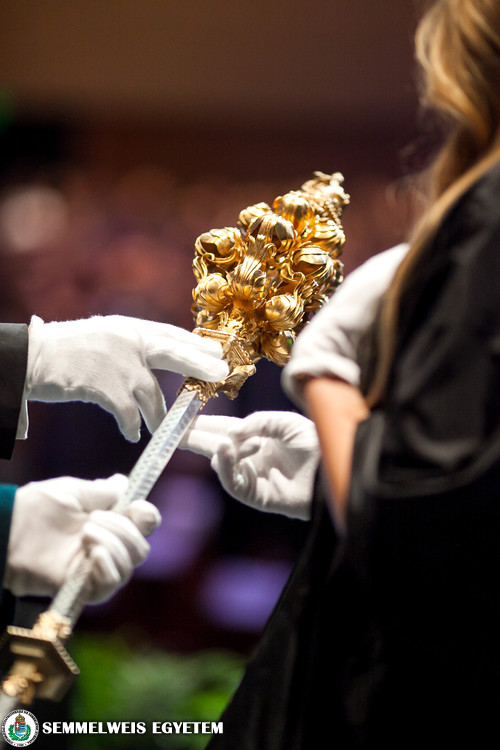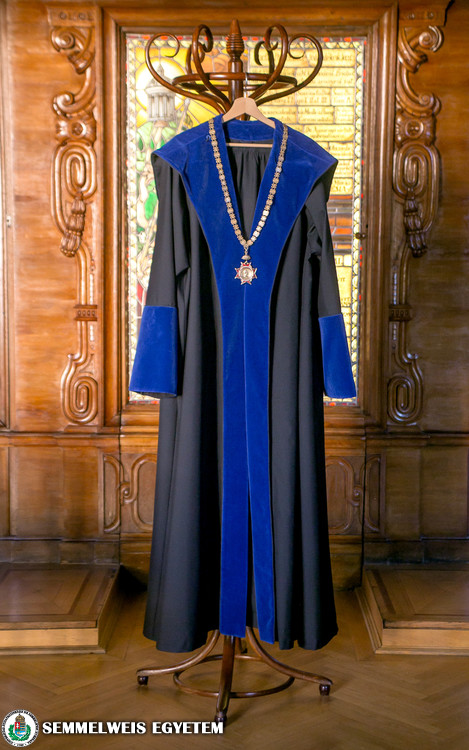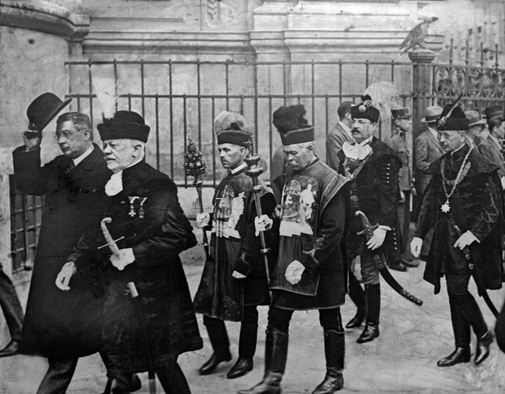The various regalia of office and dignity, that is, the sceptre and the chains of office, have always been important accessories of university life, and similarly to festive occasions and celebrations, they serve the building and maintaining of an academic community. In the second part of our series in the lead-up to the 250th anniversary of the university’s founding, we will present a brief overview of the history of these regalia and celebrations.
 We generally know the origins of our regalia, although it is the past of the oldest one, the historical medical faculty sceptre, that we know the least about. The most likely of the different expert opinions puts the date it was made around the time the medical faculty was established, which was 1769. The sceptre is tipped with a statue of the physician evangelist Saint Luke, while on the first node, the figures of Cosmas and Damian, the two martyr physician saints are visible, who are also the patron saints of the medical faculty. On festive occasions, the sceptres (called pedum or sceptrum in Latin) were carried in front of the rector and the deans by porters dressed in heraldic tabards; today, this task is carried out by students dressed as traditional hajduks (male attendants dressed in semi-military Hungarian costume). Oaths of office (e.g. at commencements) are taken with fingers touching the sceptre.
We generally know the origins of our regalia, although it is the past of the oldest one, the historical medical faculty sceptre, that we know the least about. The most likely of the different expert opinions puts the date it was made around the time the medical faculty was established, which was 1769. The sceptre is tipped with a statue of the physician evangelist Saint Luke, while on the first node, the figures of Cosmas and Damian, the two martyr physician saints are visible, who are also the patron saints of the medical faculty. On festive occasions, the sceptres (called pedum or sceptrum in Latin) were carried in front of the rector and the deans by porters dressed in heraldic tabards; today, this task is carried out by students dressed as traditional hajduks (male attendants dressed in semi-military Hungarian costume). Oaths of office (e.g. at commencements) are taken with fingers touching the sceptre.
The origin of the original dean’s chain of office – which the chains of office used today were based on – is well known. The series of chains, comprised of one for the rector and four for the deans, was ordered to be made by Francis I, Emperor of Austria and King of Hungary, in 1819, and were presented to the leaders of the university at an official ceremony held on May 18, 1820. The gold coin set in the center of the medallion features the profile of the donor, Emperor and King Francis I. Similar chains were given earlier to the universities of Vienna and Lemberg, and a little later to those in Innsbruck, Graz and Olmütz. These chains went on to be used for almost 130 years at the university in Pest. After the Communists took power following World War II, a 1949 ministry directive banned the use of all university regalia, and thus they were handed over to the National Museum on May 31, 1949.
 Later, starting from 1957, the leadership of the now-independent institution Medical University of Budapest (BOTE) fought a lengthy struggle to recover these regalia from the National Museum. The effort was eventually successful in the summer of 1959, and in order to safeguard the objects that were now considered museum pieces, various security measures were also implemented. Eventually, BOTE had new chains of office (but not sceptres) made in the early 1960s.
Later, starting from 1957, the leadership of the now-independent institution Medical University of Budapest (BOTE) fought a lengthy struggle to recover these regalia from the National Museum. The effort was eventually successful in the summer of 1959, and in order to safeguard the objects that were now considered museum pieces, various security measures were also implemented. Eventually, BOTE had new chains of office (but not sceptres) made in the early 1960s.
Following a decision by the leadership of BOTE, the sceptre and the chains – along with numerous other museum memorabilia – were deposited at the newly established Semmelweis Museum of Medical History in February 1968, and were then reclaimed by the university in 1994, for its 225th anniversary exhibition. These formed the basis for the replicas that were created and that we still use today. Every faculty received its own chain of office, but there remains only one sceptre, that of the historical medical faculty, which now symbolizes the entire university.
The regalia are generally used and worn on special occasions and celebrations held by the university, such as the opening of the academic year, the Dies Academicus and Semmelweis Day.
 Since from its establishment in 1635 until its “nationalization” ordered by Empress Maria Theresa in 1769 the university was operated by the Jesuit Order, the opening and ending of the academic years also followed the rules of the order; thus until 1945, academic years were opened with the Veni Sancte mass and closed with the Te Deum. The regalia worn varied from period to period: for example, university office holders did not wear academic regalia during the period of the Austro-Hungarian Monarchy or between the two world wars; instead, they appeared in their own Hungarian ceremonial attire. The chains of honor they wore indicated the offices they held. During the majority of the years under communism, university leaders wore neither academic regalia nor chains of honor; the decision to create an academic dress was made in 1969.
Since from its establishment in 1635 until its “nationalization” ordered by Empress Maria Theresa in 1769 the university was operated by the Jesuit Order, the opening and ending of the academic years also followed the rules of the order; thus until 1945, academic years were opened with the Veni Sancte mass and closed with the Te Deum. The regalia worn varied from period to period: for example, university office holders did not wear academic regalia during the period of the Austro-Hungarian Monarchy or between the two world wars; instead, they appeared in their own Hungarian ceremonial attire. The chains of honor they wore indicated the offices they held. During the majority of the years under communism, university leaders wore neither academic regalia nor chains of honor; the decision to create an academic dress was made in 1969.
The schedule of the academic years was changed in 1876; as a result, the opening ceremonies for the year have been held in September since then, compared to the previous November. However, our other celebration, the Dies Academicus, or the day of the university, is still held on a day close to November 7. The origin of this date is that the decree on organizing the medical faculty was issued by Maria Theresa on November 7, 1769, thus the 100th and 200th anniversaries were also counted from this date.
For a long time, the date of the university’s moving to Buda in 1777 and its subsequent reorganization was also a celebrated holiday, tied to the Diploma Inaugurale, signed by Maria Theresa on March 25, 1780. However, after World War II the celebration fell out of practice.
One of the university’s newest celebrations also acts as the closing event of the academic year. We celebrate Semmelweis Day, the birthday of our namesake Ignác Semmelweis, on July 1. 1985 marked the first year that distinctions and recognitions were handed out by the university on Semmelweis Memorial Day.
László Molnár
Translation: Tamás Deme
(Source used: József Papp: Traditions and Memorabilia at Eötvös Loránd University of Science. Bp., 1982.)


